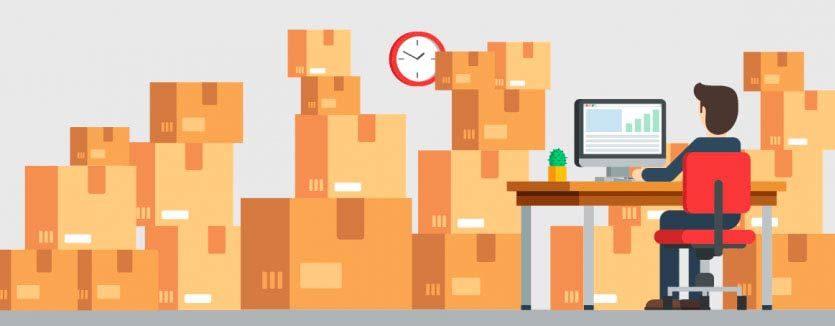
For an online sales business or a manufacturing company, it’s all about the supply chain. It covers everything from the procurement of items for sale, or raw materials for the production process, to delivery of the items or products. Controlling the supply chain and keeping oversight on it is, as would be expected, supply chain management (SCM). Order processing is the central pillar of SCM; in a way, it’s the heart of the whole fulfillment process.
In this blog, we’re going to take a close look at how order processing works, and explore its importance to supply chain management.
Order processing goes into effect the minute customers select and pay for goods online and continues until those goods are received. Broad in scope, it follows defined steps to get to that end point.
Here’s how the process breaks down:
As soon as customers have filled their online carts and paid for their goods, their orders are transmitted to the warehouse or fulfillment center. Here they’re broken down into their component parts, which means product, quantity, size/color (if relevant), etc.
If the sales or fulfillment company is large enough, these order details are processed by an automated inventory management system (IMS). This sophisticated software will know if customers’ goods are in stock, and if so where they are. In essence, the system is able to determine the best warehouse to route the order to; and if some items aren’t available right away, it will give instructions to send them as, and when, they are. In addition, if a customer has put in more than one order, the IMS can consolidate them into one package.
Picking describes the actual job of collecting items for an order from their storage spaces. Pickers do the job. Warehouses can be large—some are gargantuan—so getting organization into this process can be complicated. Picking can either be done on an individual-order basis, by warehouse zone, or in bulk – which means picking for several orders at the same time.
Irrespective of the method used, the whole process starts with a picking list that itemizes everything according to its storage location and sets out a route round the warehouse for the pickers to take. The aim, of course, is to cut down the picking time.
After picking, items are taken to a sorting area. If they were picked in bulk or by warehouse zone, this is the area where they’ll be sorted into their individual orders. This is also the time when items are checked against the original orders to make sure everything is there, is in good order, and of high quality.
Making sure the appropriate packaging is used is trickier than might be thought. The box itself should be the right size for the items and strong enough to hold them during shipping, and the padding inside should be enough to protect the contents, but light enough to keep transportation costs down. Sometimes this padding has to be specialized. If food is being packed, for instance, it might have to be kept cool with gel packs or dry ice.
After being packed up, shipping labels are attached.
We’re now near the end of order processing. After boxing and labeling, shipments are organized by geographical location and assigned to their respective delivery trucks. Size and weight might also be a consideration when selecting transport: extra heavy items, or those that need refrigeration, will need specialized trucks. At this stage, the type of delivery a customer paid for also has to be taken into consideration. Expedited delivery, for example, will be given priority. The point is that it’s important to deliver an item at the time the customer expects it.
Order delivery is the last step of the order processing system. The customer can choose a particular time to have their order delivered, or they can leave special instructions, like having the package be left with a neighbor. If a customer has opted for Cash on Delivery (COD), the delivery drive will be the one who collects the payment.
Order processing is the core, the beating heart at the center of the supply chain system that everything else more or less has to service. In essence, for any sales, fulfillment, or manufacturing entity, processing orders – getting them together and getting them to the right customer in time – is what they’re about. It’s true that without proper management in any area of the supply chain businesses won’t perform at their best, but when it comes to order processing, its efficiency, speed, accuracy, and cost-effectiveness are actually the determining factors of success and, ultimately, profit.
Whatever way you look at it, though, supply chain management is a complex operation. That’s why it’s a good idea to automate it.
The upsides of automation are:
Having looked closely at the complete supply chain, we can see that everything centers on the order processing part. Putting orders together and getting them to customers is, in effect, the commercial activity that reasons for the company’s existence.
Automating all or some of the areas of supply chain management with an inventory management system can be of great benefit to a company, both logistically and financially. Cin7 is one of the best.
To learn more about how Cin7 can help your business, you can book a demo from one of our experts by clicking here.


Some economists are predicting a mild recession in 2022 in the United States as consumer spending slows in response to inflation. As a product-based business owner, you need strategies to help you weather any recession. By leveraging technology to manage your inventory, you can survive any challenging situation. Cin7’s inventory management software is your best […]

This is a guest blog post written by Cin7 partner, Marsello. Learn more about our partner program. Email marketing is a key sales tactic for retailers and product sellers, so it’s important to have an active, responsive database. That means consistent or growing engagement (open and click rates), a high repeat purchase rate, and growing […]

Amazon.com is undoubtedly the number one name in ecommerce. It has dwarfed every other ecommerce platform. Thus, if you are thinking about becoming —or already are — an Amazon seller, you are on the right path to increasing your turnover. How can we help take you further? Here are 12 reasons why using the Cin7 […]